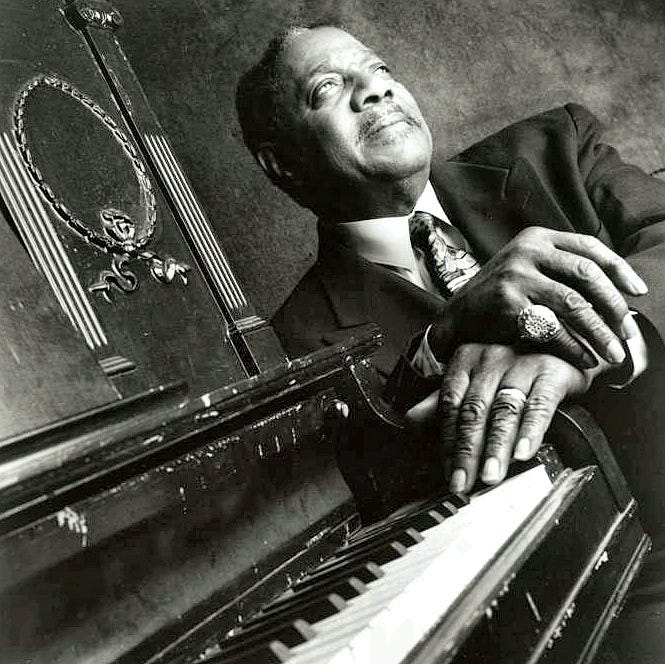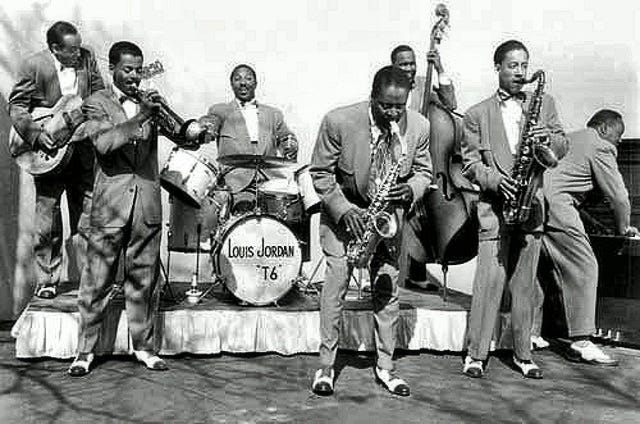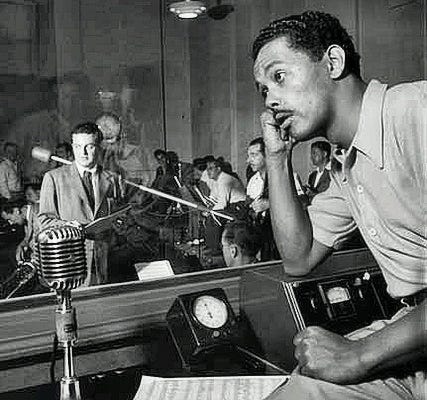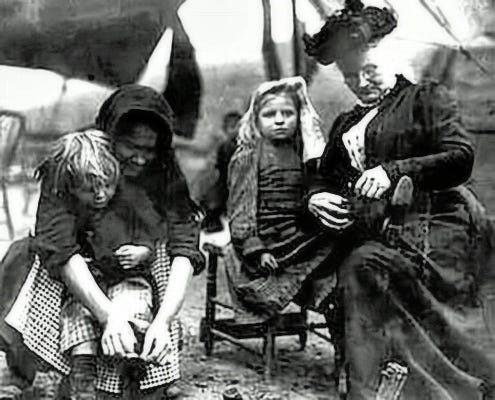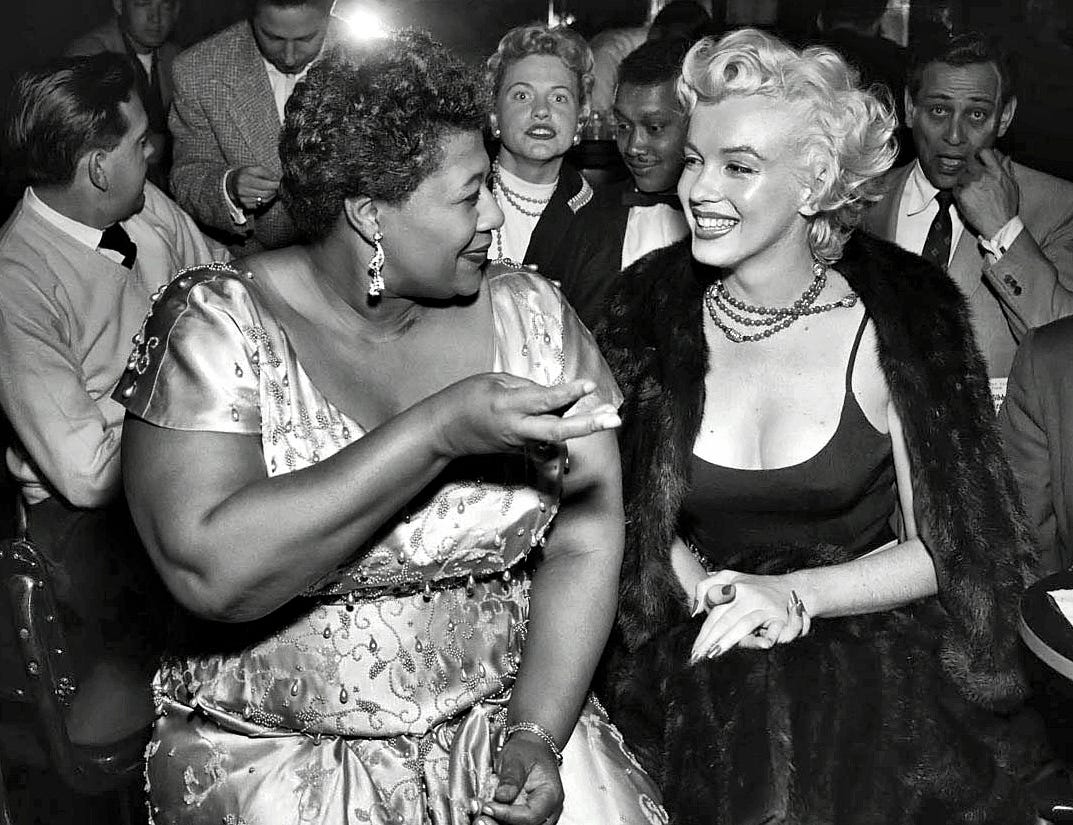Joan Osborne, singer-songwriter, is 61 years old today
Joan Osborne, New York City, 2012
Photo by Frank Beacham
Joan Osborne is 61 years old today.
A singer-songwriter, Osborne has recorded and performed in various popular musical genres including pop, soul, R&B, blues and country. She is best known for her song "One of Us."
She has toured with Motown sidemen, the Funk Brothers, and was featured in the documentary film about them, Standing in the Shadows of Motown.
Originally from Anchorage, Kentucky, an affluent suburb of Louisville, Osborne moved to New York City in the late 1980s, where she formed her own record label, Womanly Hips, to release a few independent recordings. She signed with Mercury Records, and released her first full length album, Soul Show: Live at Delta 88, in 1991.
Her second (and first major label) album was Relish (1995), which became a hit on the strength of the single, "One of Us." Apart from this song, the rest of the album was steeped in country, blues and folk music. "Right Hand Man" and "St. Teresa" became minor hits following the success of "One of Us."
In 2001, Osborne appeared on Austin City Limits, singing material mainly from Righteous Love. In a brief interview segment at the end of the episode, Osborne reflected on her gladness to have gotten out of the limelight of her mid-90's stardom.
She was featured in the 2002 documentary film, Standing in the Shadows of Motown, and toured with the Motown sidemen, the Funk Brothers.
She and her band accompanied the Dixie Chicks for a national tour in the summer of 2003, during which time she also joined veteran San Francisco jam-rockers, The Dead, as a vocalist. She then released her fourth album, How Sweet It Is, a collection of classic rock and soul covers.
During 2005 and 2006, Osborne performed on numerous occasions with Phil Lesh and Friends. In February, 2007, she appeared on the Grand Ole Opry.
In May, 2007, she issued, Breakfast in Bed, a return to the soul music that she had covered on How Sweet It Is. Breakfast in Bed also featured the two songs ("Heatwave" and "What Becomes of the Brokenhearted") that she had covered for the film, Standing in the Shadows of Motown.
Osborne sang lead vocals on the cover of "Spoonful" on Vivian Campbell's solo album, Two Sides Of If. She also provided some vocals for "Wayfaring Stranger" on Spearhead's 1997 album, Chocolate Supa Highway. She covered Dolly Parton's "Do I Ever Cross Your Mind" on the 2003 tribute album, Just Because I'm a Woman: Songs of Dolly Parton.
She is featured on the Holmes Brothers 2007 collection, State of Grace, performing "Those Memories of You," an old Allan O'Bryant bluegrass tune. Her album, Little Wild One, was released in September, 2008. Osborne performs as a guest vocalist on Sgt. Pepper Live, the 2009 album and DVD by Cheap Trick. She performed with The Waybacks at Merlefest, 2011, during the Hillside Album hour, featuring The Allman Brothers' Eat a Peach.
Osborne is currently a member of Trigger Hippy, along with Steve Gorman, Tom Bukovac, Jackie Greene and Nick Govrik. Trigger Hippy released their debut album on September 30, 2014.
On September 1, 2017, Osborne released a new album — Songs of Bob Dylan. It was Osborne’s ninth full-length album.
Here, Osborne performs Jimmy Ruffin’s “What Becomes of the Broken Hearted” with the Funk Brothers from the 2002 documentary, Standing in the Shadows of Motown.
Johnnie Johnson, blues musician who worked with Chuck Berry, was born 99 years ago today.
Born Johnnie Clyde Johnson in Fairmont, West Virginia, Johnson began playing piano in 1928. He joined the U.S. Marine Corps during World War II where he was a member of Bobby Troup's all serviceman jazz orchestra, The Barracudas.
After his return, he moved to Detroit and then Chicago, where he sat in with many notable artists, including Muddy Waters and Little Walter. He moved to St. Louis, Missouri in 1952 and immediately put together a jazz and blues group, The Sir John Trio with drummer Ebby Hardy and saxophonist, Alvin Bennett. The three scored a regular gig at the Cosmopolitan Club in East St. Louis.
On New Year's Eve 1952, Alvin Bennett had a stroke and could not perform. Johnson, searching for a last minute replacement, called a young man named Chuck Berry, the only musician Johnson knew who because of his inexperience, would likely not be playing on New Year's Eve.
Although then a limited guitarist, Chuck Berry added vocals and showmanship to the group. As Bennett would not be able to play again because of his stroke, Johnson hired Berry as a permanent member of the trio.
They would remain the Sir John's Trio until Berry took one of their tunes, a reworking of Bob Wills' version of "Ida Red" to Chess Records. The Chess brothers liked the tune and soon the trio were in Chicago recording "Maybellene" and "Wee Wee Hours" — a song Johnson had been playing as an instrumental for years for which Berry quickly penned some lyrics.
By the time the trio left Chicago, Berry had been signed as a solo act and Johnson and Hardy became part of Berry's band. "I figured we could get better jobs with Chuck running the band. He had a car and rubber wheels beat rubber heels any day," said Johnson.
Over the next twenty years, the two collaborated in the arrangements of many of Berry's songs including "School Days," "Carol" and "Nadine." The song "Johnny B. Goode" was reportedly a tribute to Johnson, with the title reflecting Johnson's usual behavior when he was drinking.
The pianist on the "Johnny B. Goode" session was Lafayette Leake, one of the two main session pianists for Chess (the other being Otis Spann). Leake also played on "Oh Baby Doll," "Rock & Roll Music," "Reelin' and Rockin'" and "Sweet Little Sixteen."
Berry and Johnson played and toured together until 1973. Although never on his payroll after 1973, Johnson played occasionally with Berry until Johnson's death in 2005.
Johnson was known to have a serious drinking problem. In Chuck Berry's autobiography, Berry tells of how he declared there would be no drinking in the car, while on the road.
Johnson and bandmates complied with the request by putting their heads out the window. Johnson denied the story, but said he did drink on the road. Johnson quit drinking entirely in 1991, after nearly suffering a stroke on stage with Eric Clapton.
Johnson received little recognition until the Chuck Berry concert documentary, Hail! Hail! Rock 'n' Roll in 1987. That attention helped Johnson, who was supporting himself as a bus driver in St. Louis at the time, return to music.
He recorded his first solo album, Blue Hand Johnnie, that same year. He later performed with Keith Richards, Eric Clapton, John Lee Hooker, Bo Diddley and George Thorogood on Thorogood's 1995 live album, Live: Let's Work Together.
In 1996 and 1997, Johnson toured with Bob Weir's band, Ratdog, playing 67 shows.
In 1999, Johnson's biography was released, Father of Rock and Roll: The Story of Johnnie B. Goode Johnson by 23-year-old Travis Fitzpatrick. The book was nominated for a Pulitzer Prize by Congressman John Conyers and garnered Johnson more recognition.
In November, 2000, Johnson sued Berry, alleging he deserved co-composer credits (and royalties) for dozens of songs, including "No Particular Place To Go," "Sweet Little Sixteen" and "Roll Over Beethoven," that credit Berry alone. The case was dismissed in less than a year because too many years had passed since the songs in dispute were written.
Johnson died on April 13, 2005 at age 80.
Here, Johnson performs “Real Good Woman” in 2003
Louis Jordan Band, 1948
Louis Jordan was born 115 years ago today.
A pioneering musician, songwriter and bandleader, Jordan was popular from the late 1930s to the early 1950s. Known as "The King of the Jukebox,” he was highly popular with both black and white audiences in the later years of the swing era.
Jordan was one of the most successful African-American musicians of the 20th century, ranking fifth in the list of the all-time most successful black recording artists according to Billboard magazine's chart methodology.
He had at least four million-selling hits during his career and regularly topped the R&B "race" charts. He was one of the first black recording artists to achieve significant crossover in popularity with the mainstream (predominantly white) American audience, having simultaneous Top Ten hits on the white pop charts on several occasions.
After Duke Ellington and Count Basie, Jordan was probably the most popular and successful African-American bandleader of his time. He was a talented singer with great comedic flair, and he fronted his own band for more than twenty years.
Jordan duetted with some of the biggest solo singing stars of his time, including Bing Crosby, Ella Fitzgerald and Louis Armstrong. He was also an actor and a major black film personality.
He appeared in dozens of "soundies,” made numerous cameos in mainstream features and short films, and starred in two musical feature films made especially for him. He was an instrumentalist who played all forms of the saxophone but specialized in the alto. He also played the piano and clarinet.
Jordan began his career in big-band swing jazz in the 1930s, but he became famous as one of the leading practitioners, innovators and popularizers of jump blues, a swinging, up-tempo, dance-oriented hybrid of jazz, blues and boogie-woogie.
Typically performed by smaller bands consisting of five or six players, jump music featured shouted, highly syncopated vocals and earthy, comedic lyrics on contemporary urban themes. It strongly emphasized the rhythm section of piano, bass and drums. After the mid-1940s, this mix was often augmented by electric guitar. Jordan's band also pioneered the use of the electric organ.
Here, Jordan performs “Caldonia” in 1946
Billy Eckstine was born 109 years ago today.
A singer of ballads and a bandleader of the swing era, Eckstine's smooth baritone and distinctive vibrato broke down barriers throughout the 1940s, first as leader of the original bop big-band then as the first romantic black male in popular music.
Eckstine's paternal grandparents were William F. and Nannie Eckstein, a mixed-race, lawfully married couple who lived in Washington, D.C. Both were born in 1863. Eckstine’s parents were William Eckstein, a chauffeur, and Charlotte Eckstein, a seamstress. Their son was born in Pittsburgh and began singing at the age of seven and entered many amateur talent shows.
An influence looming large in the cultural development of soul and R&B singers from Sam Cooke to Prince, Eckstine was able to play it straight on his pop hits "Prisoner of Love," "My Foolish Heart" and "I Apologize."
He had originally planned on a football career, but after breaking his collar bone he made music his focus. After working his way west to Chicago, Eckstine joined Earl Hines' Grand Terrace Orchestra in 1939, staying with the band as vocalist and, occasionally, trumpeter, until 1943. By that time, he had begun to make a name for himself through the Hines band's radio shows with such jukebox hits as "Stormy Monday Blues" and his own, "Jelly Jelly."
In 1944, Eckstine formed his own big band and made it a fountainhead for young musicians who would reshape jazz by the end of the decade, including Dizzy Gillespie, Dexter Gordon, Miles Davis, Art Blakey, Charlie Parker and Fats Navarro. Tadd Dameron and Gil Fuller were among the band's arrangers and Sarah Vaughan gave the vocals a contemporary air.
The Billy Eckstine Orchestra was the first bop big band, and its leader reflected bop innovations by stretching his vocal harmonics into his normal ballads. Despite the group's modernist slant, Eckstine hit the charts often during the mid-1940s, with Top Ten entries including "A Cottage for Sale" and "Prisoner of Love."
On the group's frequent European and American tours, Eckstine, popularly known as Mr. B, also played trumpet, valve trombone and guitar.
Dizzy Gillespie, in reflecting on the band in his 1979 autobiography, To Be or Not to Bop, gives this perspective: "There was no band that sounded like Billy Eckstine's. Our attack was strong, and we were playing bebop, the modern style. No other band like this one existed in the world."
After a few years of touring with road-hardened be-boppers, Eckstine became a solo performer in 1947, and seamlessly made the transition to string-filled balladry. He recorded more than a dozen hits during the late 1940s, including "My Foolish Heart" and "I Apologize."
Eckstine was one of the first artists to sign with the newly-established MGM Records, and had immediate hits with revivals of "Everything I Have Is Yours" (1947), Richard Rodgers’ and Lorenz Hart’s "Blue Moon" (1948) and Juan Tizol’s "Caravan" (1949).
While enjoying success in the middle-of-the-road and pop fields, Eckstine occasionally returned to his jazz roots, recording with Vaughan, Count Basie and Quincy Jones for separate LPs. He regularly topped the Metronome and Down Beat polls in the Top Male Vocalist category.
Eckstine was a style leader and noted sharp dresser. He designed and patented a high roll collar that formed a "B" over a Windsor-knotted tie, which became known as a "Mr. B. Collar." In addition to looking cool, the collar could expand and contract without popping open, which allowed his neck to swell while playing his horns.
Legend has it that his refined appearance even had an effect on trumpeter Miles Davis. Once, when Eckstine came across a disheveled Davis in the depths of his heroin excess, his remark — "Looking sharp, Miles" — served as a wake-up call for Davis, who promptly returned to his father's farm in the winter of 1953 and finally kicked the habit.
In 1984, Eckstine recorded his final album, I Am a Singer, arranged and conducted by Angelo DiPippo and featuring Toots Thielemans on harmonica.
He died on March 8, 1993 at age 78.
His friend, Duke Ellington, recalled Eckstine's artistry in his 1973 autobiography, Music is My Mistress: "Eckstine-style love songs opened new lines of communication for the man in the man-woman merry-go-round, and blues a la B were the essence of cool.
“When he made a recording of Caravan, I was happy and honored to watch one of our tunes help take him into the stratosphere of universal acclaim. And, of course, he hasn't looked back since. A remarkable artist, the sonorous B. His style and technique have seen extensively copied by some of the neocommercial singers, but despite their efforts he remains out front to show how and what should have been done."
Beck Hansen, known by the stage name as Beck, is 53 years old today.
A musician, singer-songwriter and multi-instrumentalist, Beck rose to fame in the early 1990s with his lo-fi, sonically experimental style, and he became known for creating musical collages of a wide range of styles. His later recordings encompass folk, funk, soul, hip hop, alternative rock, country and psychedelia.
Born in Los Angeles, Beck discovered hip hop and folk music in his teens and began to perform locally at coffeehouses and clubs. He moved to New York City in 1989 and became involved in the city's small, but intense, anti-folk movement.
After returning to his hometown in the early 1990s, he cut his breakthrough single "Loser," which became a worldwide hit in 1994. His 1996 release, Odelay, produced hit singles and topped critic polls. He released the stripped-down, Mutations, in 1998, and the funk-infused, Midnite Vultures, in 1999.
The downcast, acoustic, Sea Change (2002), showcased a more serious Beck, and 2005's Guero returned to sample-based production. The Information (2006) was inspired by electro-funk and hip hop, and Modern Guilt (2008), likewise, by 1960s music.
Beck has been hailed throughout his musical career as being among the most creative and idiosyncratic musicians of 1990s and 2000s alternative rock.
Here, Beck performs “Where It’s At” in 1996.
Mary Harris "Mother" Jones staged a "Children's Crusade" 120 years ago to protest child labor in textile mills and mines.
Accompanied by child workers, she walked from Philadelphia to President Theodore Roosevelt's home in Oyster Bay, New York to protest the plight of child laborers. They carried signs that said: “We want to go to school and not the mines!”
The struggle to keep children from working in textile mills and mines would go on for years. It finally came to head with many other issues in the Textile Strike of 1934.
On the morning of September 6, 1934, in the tiny town of Honea Path, South Carolina, my home town, seven people were killed and 30 others wounded in violence caused by mill management over the strike. The man who ran that mill was my grandfather.
For 60 years, the story of a mass killing in a small town was successfully erased, not only from the history books, but from the public consciousness of those people most affected by it. The story of the killings was revealed in 1995.
The disillusionment of the workers and the outrageous conduct by the mill owners, especially in Honea Path, made a strong impression on the administration of President Franklin Roosevelt.
This helped spur passage of the Wagner Act in 1935 and the Fair Labor Standards Act in 1938. Out of these laws came reforms that vastly improved the lives of all workers, even in states where unionization didn’t take hold.
One major example was child labor, the subject of Mother Jones’ protest. The Fair Labor Standards Act in 1938 outlawed employment of children under sixteen in textile mills. It was a major milestone.
Because this practice is now illegal, children have a better chance at a quality life by staying in school rather than being exploited as cheap labor. Other major reforms that came out of the labor unrest were the establishment of the minimum wage and the 40 hour work week.
The story of the labor violence in Honea Path is in my book, “Whitewash: A Southern Journey through Music, Mayhem and Murder.”
In 1955, Marilyn Monroe learned the Mocambo, a popular Hollywood nightclub, would not book Ella Fitzgerald because she was black.
Monroe phoned the manager and told him she would reserve a front row table every night Ella performed there — knowing that her presence would get a lot of press and publicity for the club.
Soon, Ella became the first African American to perform at the Mocambo, and as promised, Marilyn was seated up front to enjoy her favorite singer.
Palau De Les Arts Reina Sofia, Valencia, Spain, 2014
Photo by David Leventi




